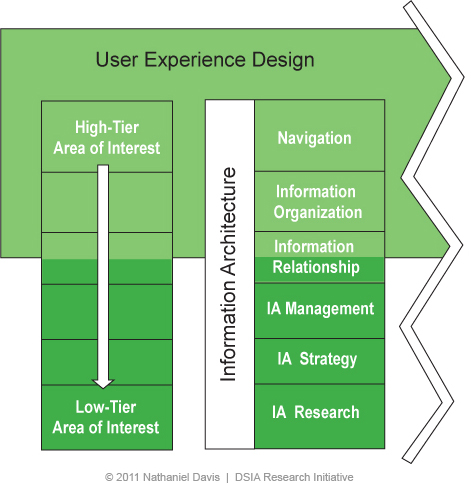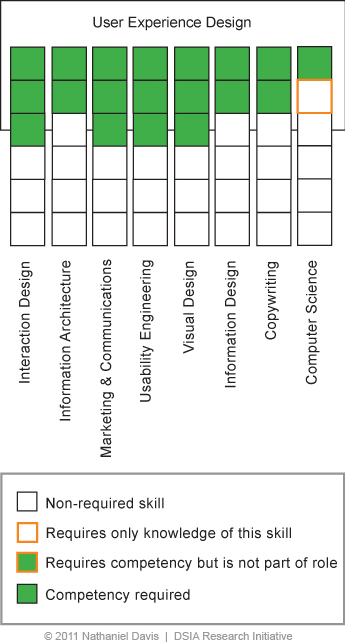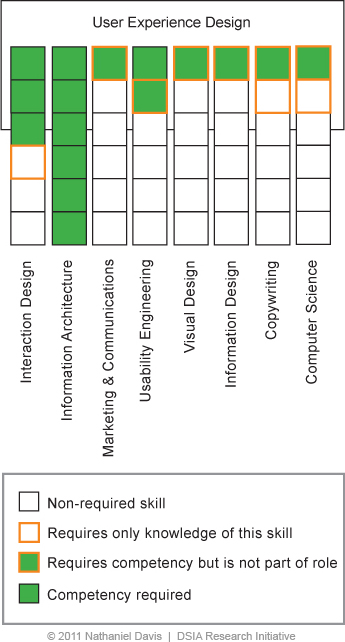
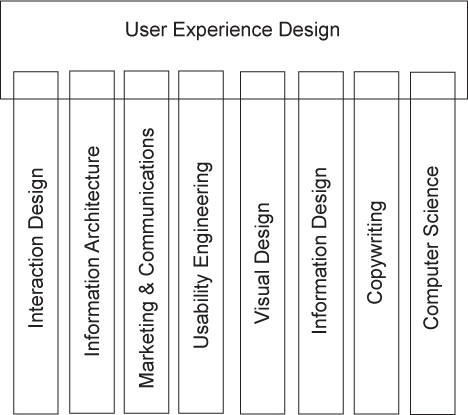
To help you navigate the practice of information architecture—and set the context for my future columns—I’d like to confirm that it’s important to view the practice of information architecture—and its relationship to the practice of user experience design—through the lens of the Boersma T-model.
Now that we have the Boersma T-model as a reference, I’d like to make the information architecture vertical less abstract by filling it in, in Figure 2, with the six primary areas of interest that encapsulate the practice of information architecture that I explored in my last column, Framing the Practice of Information Architecture.
If we use the Boersma T-model, we can refer to the practice of information architecture as a practice vertical![]() within the domain of user experience design that includes the following:
within the domain of user experience design that includes the following:
- Navigation of information domains
- Organization of information within a domain
- associative Relationships of information within a domain
- Management of information architecture
- Strategies for information architecture
- ongoing Research for information architecture within a domain
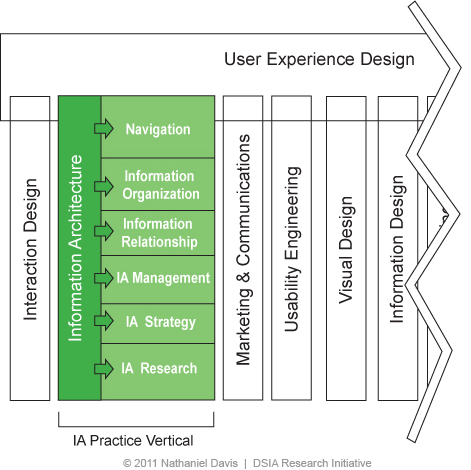
We can explore any IA subject matter through these six primary areas of interest for an IA practice of one or many. In this column, I’d like to discuss a topic relating to IA management. However, before we begin, it’s important to note that discussions around IA management usually focus on two areas:
- management of information architectures that we create
- management of practitioners who create information architectures—the focus of this column
Using the Boersma T-model, let’s explore how to set the criteria for a qualified practitioner of information architecture and why we need better communication of these criteria to help both junior and senior professionals become more qualified candidates.
IA Management: The Talent Pool
An important aspect of any information architecture practice is cultivating the competencies of existing staff. I’m currently researching theoretical approaches to this topic through the DSIA Research Initiative![]() and, thus, have had an opportunity to test my insights in practice. However, while I have confidence in my methods of cultivating the talents of my existing staff, I’m not as confident about the grooming and preparation of freshman and junior practitioners, which takes place externally to my organization.
and, thus, have had an opportunity to test my insights in practice. However, while I have confidence in my methods of cultivating the talents of my existing staff, I’m not as confident about the grooming and preparation of freshman and junior practitioners, which takes place externally to my organization.
Colleges, professional training organizations, and workshops are vital to the ecosystem that produces qualified entry-level and junior professionals. However, we no longer live in a time when jobs are just waiting for recent graduates to fill them.
Nor do we practice in an industry that is forgiving of those with inadequate experience. It appears that, for many, today’s business culture doesn’t include mentoring as part of an organizational staffing model or factor ambition and passion into the hiring process. I routinely hear from junior professionals who say, “Everyone is looking for senior-level professionals with three to five years of experience.”
I recently had lunch with a fellow practitioner who reminded me of this reality. I couldn’t help but recall others’ needing the same opportunity to gain experience, in the mid-to-late ’90s, but with one major difference. At that time, there was a feast of available opportunities for someone entering the IA profession to exercise their skills to the point where they could become proficient and build a sufficient resume and portfolio rather quickly. Everyone was hiring! It was a gold rush, of sorts, with plenty of room for everyone. Jobs and opportunities flowed like the Mississippi after five days of non-stop rain. Businesses that were looking to get on the Internet were everywhere.
Eventually, the dust settled following this rush of new Web ventures—
which spanned the ridiculous to the revolutionary. Today, every business understands that they must use the Web to support their business model. From the many bright minds in the field of UX design, businesses are also learning that their Web strategies must be meaningful and/or sustainable. Thus, there is an increasing demand for UX design professionals who understand how to get to the meaningful and sustainable.
The industry of user experience has stabilized for the most part. Now, the field of user experience is dense with UX design professionals—though it is not saturated to the point where there are few opportunities. However, it is at a state where opportunities are harder to come by, because of the growing complexity of creating digital products and services that work. Producing design solutions that are accountable for meeting real business objectives and actually work is the demand that UX professionals must now meet.
As a result, a three- to five-year gap between formal training and professional readiness can be a grueling road for some eager, new practitioners of information architecture. I am concerned that the desire of many in the field—including myself—to hire senior IA practitioners, without giving new and junior practitioners any path to attaining senior-level skills, may slow our field’s ability to respond to future demand.
What I also find disturbing is the lack of competency that some senior IA practitioners, with three to five years of experience, demonstrate when looking for employment. As a manager of an IA team, I have reviewed many resumes and portfolios of IA practitioners who don’t meet the basic requirements; whose design artifacts don’t reflect what I would expect of someone with senior-level experience. Does anyone know what junior or senior means?
UX design managers, managers of information architecture, and IA practitioners should have a shared understanding of what makes a junior or senior IA practitioner a viable candidate.
